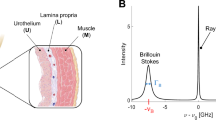Summary
The simultaneous use of a silver-staining technique, backscattered electron imaging and stereo-tilts has made it possible to visualize the spatial distribution of cell nuclei in the stretched epithelium of the bladder of mice. This study has led to the observation that a structural organization resembling the epidermal proliferative unit, previously found in the skin exists also in bladder epithelium. However, the proliferative unit in the bladder was different in that it contained a higher number of cells per unit, and an absence of columns of inactive squamous cells. These findings may indicate that epidermal proliferative unit-like structures represent a common form of organization in some epithelia.
Similar content being viewed by others
References
Allen TD, Potten CS (1974) Fine-structural identification and organization of the epidermal proliferative unit. J Cell Sci 15:291–319
Becker RP, Sogard M (1979) Visualization of subsurface structures in cells and tissues by backscattered electron imaging. Scanning Electron Microscopy 11:835–870
Bloom SE, Goodpasture C (1976) An improved technique for selective staining of nucleolar organizer regions in human chromosomes. Hum Genet 34:199–206
Carter HW (1980a) Scanning electron microscopy of specimens prepared by histochemical techniques. Micron 11:371–372
Carter HW (1980b) Backscattered electron imaging theory and application. Micron 11:259–260
Crew AV, Lin P (1976) The use of backscattered electrons for imaging purposes in a scanning electron microscope. Ultramicroscopy 1:11–18
Dean AL, Ash JE (1950) Study of bladder tumors in registry of American Urological Association. J Urol 63:618
DeNee PB, Abraham JL (1976) Backscattered electron imaging (application of atomic number contrast). In: Hayat MA (ed) Principles and techniques of scanning electron microscopy Vol. 5 Van Nostrand Reinhold, New York, pp 144–180
Farsund T (1975) Cell kinetics of mouse urinary bladder epitheli. I. Circadian and age variations in cell proliferation and nuclear DNA content. Virchows Arch (Cell Pathol) 18:35–49
Farsund T (1976) Cell kinetics of mouse urinary bladder epithelium. II. Changes in proliferation and nuclear DNA content during necrosis, regeneration and hyperplasia caused by a single dose of cyclophosphamide. Virchows Arch (Cell Pathol) 21:279–292
Fulker MJ, Cooper EH, Tanaka T (1971) Proliferation and ultrastructure of papillary transitional cell carcinoma of the human bladder. Cancer 27:21–82
Gyllensten L (1949) Contributions to the embryology of the urinary bladder. Acta Anat 7:305–344
Hicks M (1975) The mammalian urinary bladder: An accommodating organ. Biol Rev 50:215–246
Hicks RM, Wakefield J (1976) Membrane changes during urothelial hyperplasia and neoplasia. Cancer Res 36:2502–2507
Hoyes AD, Ramus NI, Martin BGH (1972) Fine structure of the epithelium of the human fetal bladder. J Anat 111: 415–425
Joy DC, Maruszenski CM (1978) The physics of the SEM for biologists. Scanning Electron Microscopy II:379–387
Mackenzie IC (1969) Ordered structure of the stratum corneum of mammalian skin. Nature 222:881–882
Mackenzie IC (1970) Relationship between mitosis and the ordered structure of the stratum corneum in mouse epidermis. Nature 226:653–655
Mackenzie IC (1975) Spatial distribution of mitosis in mouse epidermis. Anat Rec 181:705–710
Menton DN (1976) A minimum-surface mechanism to account for the organization of cells into columns in the mammalian epidermis. Am J Anat 145:1–22
Menton DN, Eisen AZ (1971) Structure and organization of mammalian stratum corneum. J Ultrastruct Res 35:247–264
Newcomb GM, Boyde A (1980) Scanning electron microscope histochemistry. The use of backscattered electrons to identify epidermal Langerhans cells in the scanning electron microscope. Histochem J 12:695–700
Noack W, Jacobson M, Schweichel JU, Jayyousi A (1975) The superficial cells of the transitional epithelium in the expanded and unexpanded rat urinary bladder. Acta Anat 93:171–183
Potten CS (1974) The epidermal proliferative unit. The possible role of the central basal cell. Cell Tissue Kinet 7:77–78
Potten CS (1976) Identification of clonogenic cells in the epidermis and the structural arrangement of the epidermal proliferative unit (EPU) In: Cairnie AB, Lala PK, Osmond DG (eds) Stem cells of renewing of cell populations. Academic Press, New York, pp 91–102
Potten CS (1981) Cell replacement in epidermis (keratopoiesis) via discrete units of proliferation. Int Rev Cytol 69:27–318
Potten CS, Allen TD (1975a) The fine structure and cell kinetics of mouse epidermis after wounding. J Cell Sci 17:413–447
Potten CS, Allen TD (1975b) Control of epidermal proliferative units (EPUs). An hypothesis based on the arrangement of neighbouring differentiated cells. Differentiation 3:161–165
Reitan J (1985) Cell numbers and ploidy classes in the normal bladder urothelium in hairless mice. Virchows Arch [Cell Pathol] 48:289–297
Stewart FA, Denekamp J, Hirst DG (1980) Proliferation kinetics of the mouse bladder after irradiation. Cell Tissue Kinet 13:75–89
Thiébaut F, Rigaut JP, Reith A (1984a) A new method for easy staining of cell junctions by silver nitrate in light and electron microscopy. Mikroskopie 41:155–162
Thiébaut F, Rigaut JP, Feren K, Reith A (1984b) Smooth-surfaced control and transformed C3H/10T1/2 cells differ in cytology. A study by secondary electron, backscattered electron and image analysis. Scanning Electron Microscopy 3:1249–1255
Thiébaut F, Rigaut JP, Feren K, Reith A (1985) Stereoscopic backscattered electron imaging of silver-stained proteins in nucleoli. Chromosoma 91:373–376
Author information
Authors and Affiliations
Rights and permissions
About this article
Cite this article
Thiébaut, F., Reitan, J.B., Feren, K. et al. An epidermal proliferative unit-like structure in the epithelium of mouse bladder observed by backscattered electron imaging. Cell Tissue Res. 246, 1–6 (1986). https://doi.org/10.1007/BF00218991
Accepted:
Issue Date:
DOI: https://doi.org/10.1007/BF00218991




